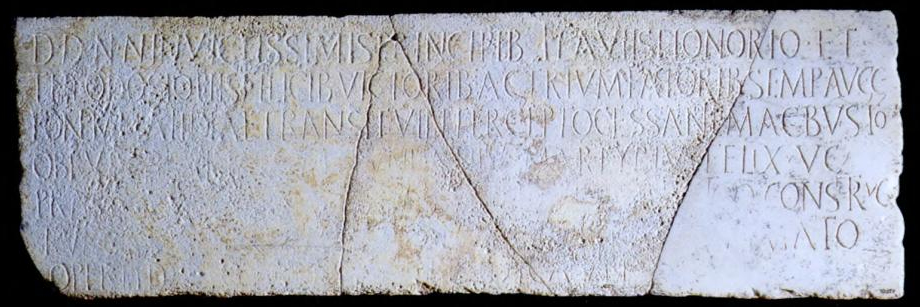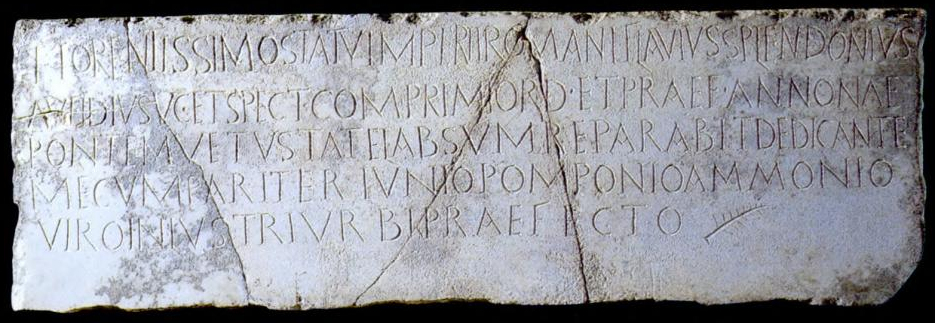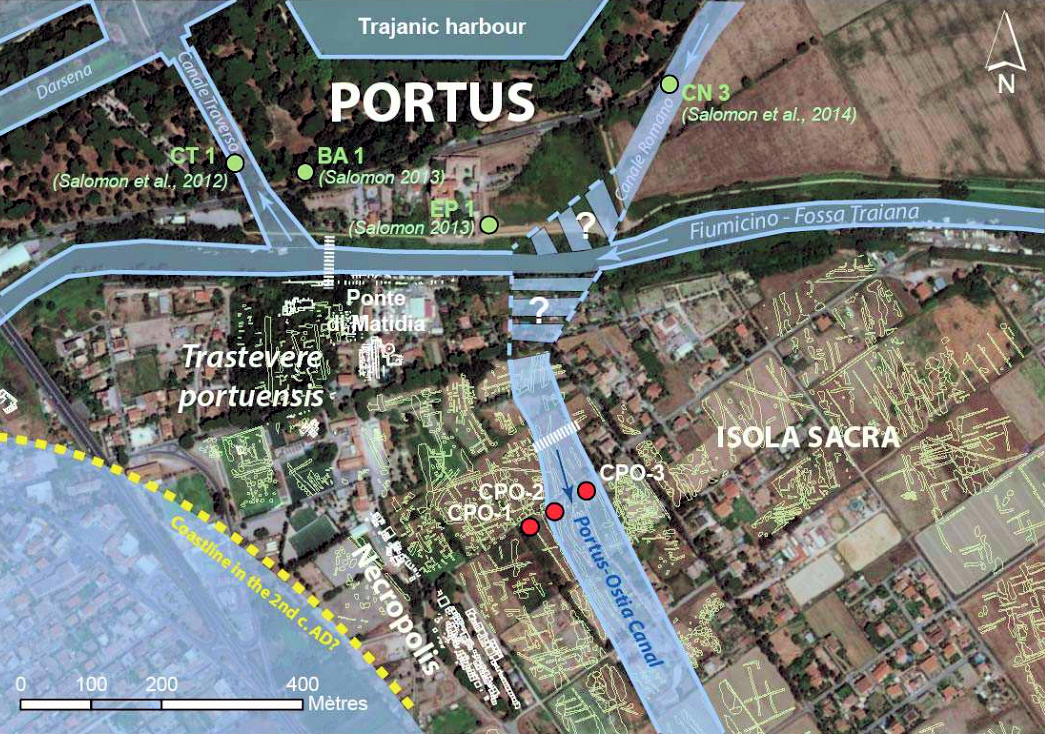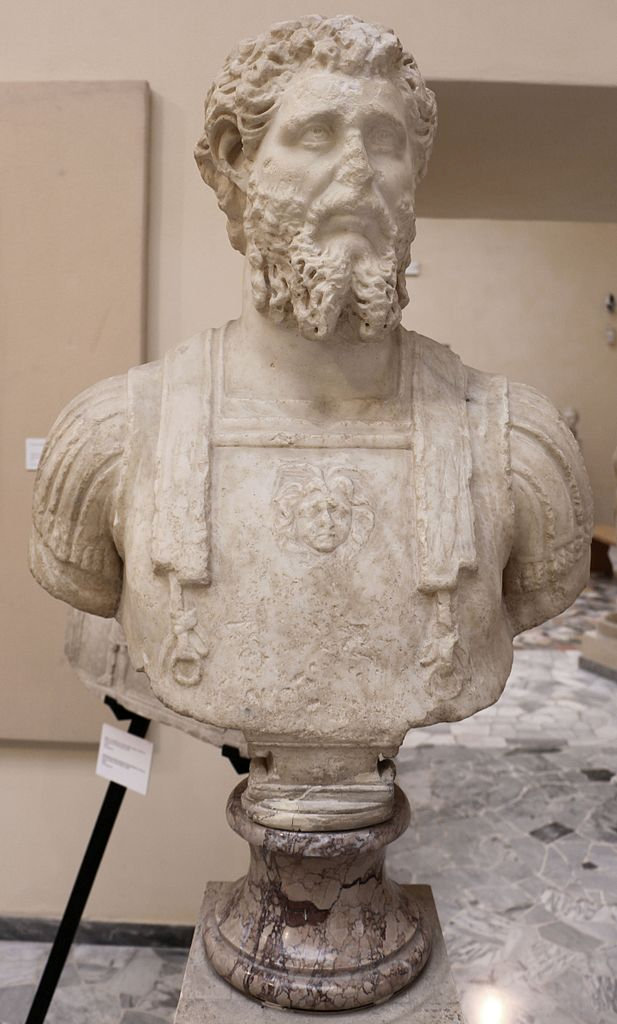Isola Sacra - Central north part - Bridge of Matidia [1]
In the early 1970's an inscription was found in the floor of a tomb on the north part of the Isola Sacra, with a text on either side. Both texts mention a bridge named after Matidia, a niece of Trajan: the Pons Matidiae. Here are the texts on the two sides of the stone:
 |
|
D(ominis) N(ostris) INVICTISSIMIS PRINCIPI(bus) FLAVIIS HONORIO ET THEODOSIO PIIS FELICIB(us) VICTORIB(us) AC TRIVMFATORIB(us) SEMP(er) AVG(ustis) PONTE(m) MATIDIAE TRANSITV INTERCEPTO CESSANTEM AC BVSTO OBRATVM [---] FVNDANIVS MARTYRIVS FELIX V(ir) C(larissimus) PRA[e(fectus) ann(onae)? ---]TOQ(ue) CONSTRVC TVM [--- con]SVMMATO OPERE IDE[m]Q[ue---] DEDICAVIT |
|
To our invincible Lords, Emperors Flavius Honorius and Flavius Theodosius, pious, happy, conquerors and triumphers, always Augusti. The Bridge of Matidia, unused because of an interrupted passage, and with burnt ruins covered, Fundanius Martyrius Felix, most illustrious man, prefect [of the food supply? ---] built [---] the work being completed [---] dedicated. |
| Marble slab. W. 1.31, h. 0.43. EDR075984. Photo: Aurea Roma, p. 72. |
 |
|
FLORENTISSIMO STATV IMPERII ROMANI FLAVIVS SPLENDONIVS AVFIDIVS V(ir) C(larissimus) ET SPECT[abilis] COM(es) PRIMI ORD(inis) ET PRAEF(ectus) ANNONAE PONTEM VETVSTATE LABSVM REPARABIT DEDICANTE MECVM PARITER IVNIO POMPONIO AMMONIO VIRO INLVSTRI VRBI PRAEFECTO |
| Marble slab. W. 1.31, h. 0.43. EDR114820. Photo: Aurea Roma, p. 72. |
A few remains of a bridge over the Fossa Traiana were found near the tomb with the inscription: abutments on both banks, covered with travertine slabs, and a central pier in the Fossa Traiana, at 11 meters from the south bank. The bridge therefore had two arches. It reached the north bank 50 meters to the east of the north-south channel leading to Trajan's basin. The upper part was probably made of wood.

The north part of the Isola Sacra with the location of the Bridge of Matidia. Image: Keay 2020, fig. 5.2.
It has been argued that the bridge was built at the end of the first century AD, in the Flavian period, as continuation of the Via Flavia. It would then have been repaired by Matidia (or perhaps the bridge was named after property that she owned, adjoining the bridge). The inscription mentioned above informs us about two rebuildings in late antiquity. The bridge was rebuilt by a prefect during the reign of Theodosius II and Honorius (412-423 AD). It had become unusable because of a fire, probably in 408 AD during an attack by Alaric and the Goths. It was rebuilt again by a Prefect of the Annona with an Urban Prefect in the fifth or early sixth century, after it had collapsed because of its age (pontem vetustate labsum reparabit).
The remains on the left bank were still visible in the 1980's, but later covered by vegetation. In 2019 they became partly visible again through the work of the association LaboraStoria.

Remains of the bridge uncovered in 2019. Photo: Il Messaggero
Perhaps a toll had to be paid for crossing the bridge. This has been suggested on the basis of many coins from the fourth century that were found in a building on the south bank. Not far away, a bit to the west, a bust of Septimius Severus was found in 1925.

Portrait-bust of the armoured Septimius Severus, found near the Bridge of Matidia.
Museum Ostia, inv. nr. 29. H. 0.78, h. of the head 0.31. Photo: Wikimedia, Sailko.